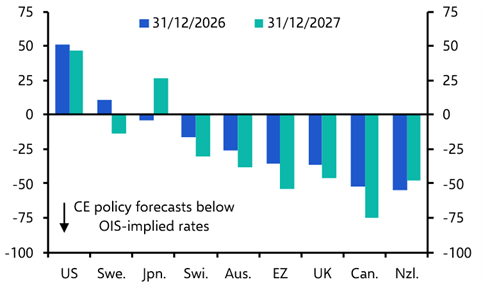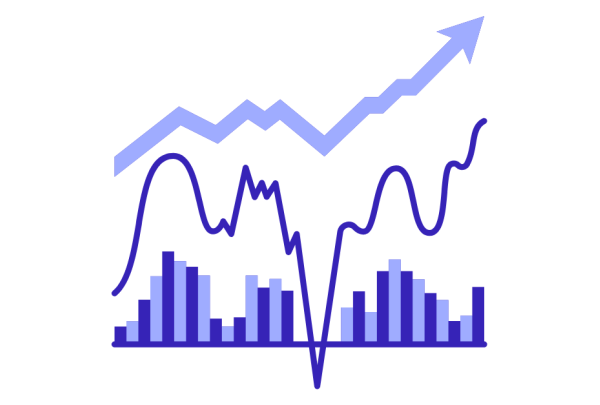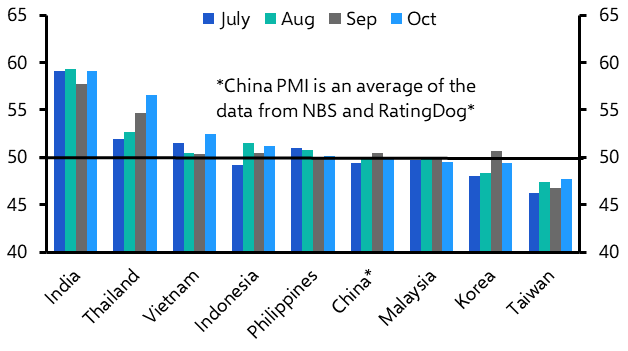Last week I discussed how our forecasts for 2019 had fared. This week, I turn my attention to what we think will happen in 2020.
The key point to emphasise is that we expect the global economy to bottom out around the first quarter of the year, with growth recovering thereafter. However, the pace of this recovery will be relatively slow and, perhaps most importantly, it will be spread unevenly across regions.
We think the US will lead the way among developed markets, as the lagged effect of looser financial conditions continues to feed through into more interest rate-sensitive parts of the economy. Meanwhile, growth is likely to pick up in several emerging markets too, including India, Brazil and Turkey (albeit at the expense of a re-emergence of macroeconomic imbalances in the latter).
At the other end of the spectrum, however, we expect the euro-zone to lag behind other advanced economies. And we think China’s economy will slow in 2020, as a modest improvement in external demand is more than offset by domestic headwinds from a weaker property sector.
Accordingly, while the world economy should start to find its feet next year, the interesting stories will play out at a regional rather than a global level.
One common thread across most major economies is that inflation will remain low. As a result, monetary policy is likely to remain supportive. Most analysts (including us) expect interest rates in the US to remain at their current low levels throughout next year. Where we differ from the consensus is that we think a combination of weak growth and low inflation will cause both the ECB and the People’s Bank of China to loosen policy further next year.
Three big political issues are likely to shape market moves next year: trade wars, the US presidential election and (in the UK at least) Brexit.
The scale of the Conservative victory in last week’s election has increased the likelihood of a “negotiated” Brexit, but there remains a risk that the UK steps back from one potential cliff-edge on January 31st (when Article 50 expires) only to step off another at the end of 2020 (by which time it must agree a comprehensive trade deal with the EU). The lingering uncertainty is likely to cap any upside for the pound and mean that, while economic growth should pick up next year, the pace of recovery is likely to be relatively modest.
Meanwhile, last week’s news that President Trump had agreed to a deal that would see Washington scale back tariffs in exchange for Beijing increasing purchases of US agricultural and other products has raised hopes of a lasting breakthrough to end the trade war. However, while this sets the stage for a truce it remains to be seen whether it holds, not least because the sheer size of the agricultural purchases the US is demanding will make it hard for China to hold up its end of the bargain.
Whatever happens, our view remains that the trade war is likely to move to a new phase over the course of next year in which the focus shifts away from tariffs and towards a broader set of issues like technology, industrial policy and security. These are likely to have fewer immediate consequences for economic activity. But US-China de-coupling will nonetheless continue. 2020 is likely to bring further evidence that the world has passed “peak” globalisation.
Finally, our US team will have a lot more to say about the economic and market implications of next year’s election over the coming months and quarters. The short version, however, is that while the outcome is likely to have a significant bearing on the equity market, it is unlikely to have a major effect on the performance of the economy over the next couple of years.
This brings us nicely to what we should expect in financial markets next year. The key point here is that asset returns in 2020 are likely to be much lower than they were in 2019. The big fall in bond yields is behind us, and we expect them to edge up a little over the course of next year. Meanwhile, we expect further gains in equity markets as the economic outlook improves. But in the absence of another big fall in bond yields it’s difficult to make the case for another double-digit increase next year. We think equity markets in most countries will rise by 5% or so.
Meanwhile, we think the US dollar will remain strong, but any appreciation in 2020 is more likely to come against the Chinese renminbi than it is against developed market currencies. And finally, we expect the prices of key commodities to head in opposite directions. Our forecast for Brent oil to top $70pb as the global economic backdrop improves puts us right at the top of the consensus range. In contrast, however, we think the price of most industrial metals will drop back as China’s economy slows. It goes without saying that we’ll be covering all of these issues, plus key risks to the view, over the course of next year. For now, though, this is the last Chief Economist’s note for 2019. On behalf of everyone at Capital Economics I’d like to wish all of our readers a happy holiday season and a prosperous new year. See you in 2020!
In case you missed it:
- Our Head of Global Economics, Jennifer McKeown, argues that the debilitation of the WTO is another sign that a golden era of globalisation is over.
- We’ve published several pieces assessing the post-election economic and financial market landscape in the UK.
- We have added two new pages to the Key Themes section of our website – one exploring whether central banks in the developed world have run out of ammunition and another exploring the long-term outlook for EMs.




